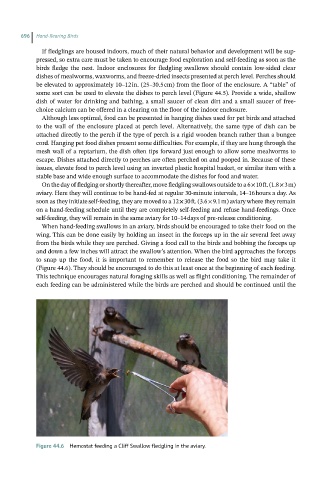Page 695 - Hand rearing birds second
P. 695
696 Hand-Rearing Birds
If fledglings are housed indoors, much of their natural behavior and development will be sup-
pressed, so extra care must be taken to encourage food exploration and self‐feeding as soon as the
birds fledge the nest. Indoor enclosures for fledgling swallows should contain low‐sided clear
dishes of mealworms, waxworms, and freeze‐dried insects presented at perch level. Perches should
be elevated to approximately 10–12 in. (25–30.5 cm) from the floor of the enclosure. A “table” of
some sort can be used to elevate the dishes to perch level (Figure 44.5). Provide a wide, shallow
dish of water for drinking and bathing, a small saucer of clean dirt and a small saucer of free‐
choice calcium can be offered in a clearing on the floor of the indoor enclosure.
Although less optimal, food can be presented in hanging dishes used for pet birds and attached
to the wall of the enclosure placed at perch level. Alternatively, the same type of dish can be
attached directly to the perch if the type of perch is a rigid wooden branch rather than a bungee
cord. Hanging pet food dishes present some difficulties. For example, if they are hung through the
mesh wall of a reptarium, the dish often tips forward just enough to allow some mealworms to
escape. Dishes attached directly to perches are often perched on and pooped in. Because of these
issues, elevate food to perch level using an inverted plastic hospital basket, or similar item with a
stable base and wide enough surface to accommodate the dishes for food and water.
On the day of fledging or shortly thereafter, move fledgling swallows outside to a 6 × 10 ft. (1.8 × 3 m)
aviary. Here they will continue to be hand‐fed at regular 30‐minute intervals, 14–16 hours a day. As
soon as they initiate self‐feeding, they are moved to a 12 × 30 ft. (3.6 × 9.1 m) aviary where they remain
on a hand‐feeding schedule until they are completely self‐feeding and refuse hand‐feedings. Once
self‐feeding, they will remain in the same aviary for 10–14 days of pre‐release conditioning.
When hand‐feeding swallows in an aviary, birds should be encouraged to take their food on the
wing. This can be done easily by holding an insect in the forceps up in the air several feet away
from the birds while they are perched. Giving a food call to the birds and bobbing the forceps up
and down a few inches will attract the swallow’s attention. When the bird approaches the forceps
to snap up the food, it is important to remember to release the food so the bird may take it
(Figure 44.6). They should be encouraged to do this at least once at the beginning of each feeding.
This technique encourages natural foraging skills as well as flight conditioning. The remainder of
each feeding can be administered while the birds are perched and should be continued until the
Figure44.6 Hemostat feeding a Cliff Swallow fledgling in the aviary.

